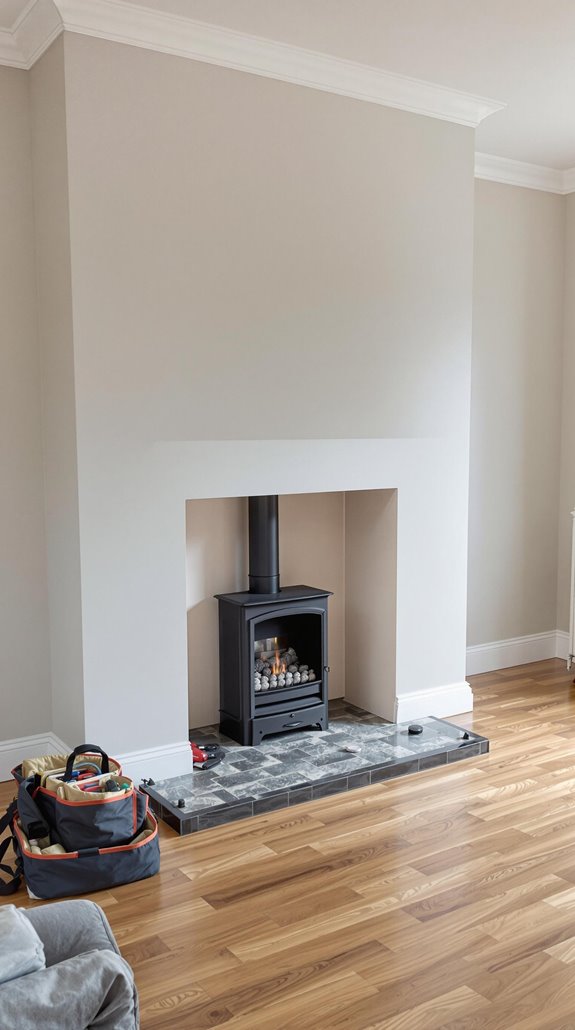I’ll walk you through the exact steps I use to safely remove gas fireplaces across the UK, ensuring you meet every legal requirement while achieving that sleek, contemporary look you’re after. From engaging the right Gas Safe registered engineer to understanding the true costs involved, there’s a specific sequence that prevents costly mistakes and dangerous oversights. The process isn’t as straightforward as you might think, and one wrong move could leave you facing serious compliance issues.
Key Takeaways
- Only Gas Safe registered engineers can legally remove gas fireplaces in the UK; DIY removal risks £20,000 fines.
- Professional removal costs £50-£100 for basic units, with complete disconnection services starting around £200.
- Notify local authority under Building Regulations Part J and retain certification for two years for insurance purposes.
- Ensure complete gas supply shutdown at mains and verify engineer credentials through official Gas Safe Register.
- Budget for additional costs including hearth removal (£200-£500) and potential chimney removal (£1,000-£1,600).
Legal Requirements for Gas Fire Removal in the UK

Before you even consider removing your gas fireplace, you’ll need to understand that UK law strictly prohibits DIY gas appliance removal. Only Gas Safe registered engineers can legally disconnect, remove, or repair your gas appliances under the Gas Safety (Installation and Use) Regulations 1998. I can’t stress this enough – unauthorized work risks prosecution and hefty fines up to £20,000. Additionally, it’s crucial to ensure that your removal is compliant with essential safety precautions to avoid any potential hazards during the process.
You’ll also need Building Regulations compliance under Part J for combustion appliances. Your engineer must notify local authority building control and provide proper certification afterward. Keep these certificates for at least two years – they’re essential for insurance validation and property sales.
Always verify your engineer’s credentials through the official Gas Safe Register before starting work. Professional engineers also carry public liability insurance to protect you from potential damages during the removal process.
Essential Safety Precautions Before Starting
Once you’ve confirmed your Gas Safe engineer is booked, you’ll need to tackle the critical safety prep work that protects both your property and everyone involved. I’ll walk you through the essential gear and setup that separates amateur mistakes from professional-grade safety.
First, gather your protective equipment: safety goggles, heavy-duty gloves, dust masks, and steel-toe boots. Keep a fire extinguisher within arm’s reach throughout the process. Next, transform your workspace by covering floors and walls with plastic sheeting, removing furniture, and sealing adjacent rooms with temporary barriers. Install proper ventilation by opening windows and positioning fans to direct dust particles outside. Always ensure the gas supply is completely shut off at the mains before beginning any removal work. Finally, set up temporary LED work lamps for clear visibility while avoiding spark risks during dismantling.
Understanding the Complete Removal Process
With your safety preparations complete, I’ll break down the five-stage removal process that transforms your gas fireplace from a functioning unit into a clean, sealed space.
Gas Supply Shutdown: I’ll engage a certified professional to handle gas supply shutdown for safety. We’ll locate the dedicated shut-off valve near your fireplace, turn it clockwise to block gas flow completely, and extinguish all pilot lights during the process. Be prepared to relight pilot lights on other gas appliances after main gas restoration.
Disconnecting Gas Lines: Using adjustable wrenches, we’ll disconnect gas line connections and cap them with appropriate fittings to prevent leaks.
Removing Surrounds: I’ll remove trim and mantels using crowbars, chiseling brick surrounds from top downward, or unscrewing prefabricated materials.
Extracting Components: We’ll carefully wiggle and remove the insert, then dismantle the firebox.
Final Sealing: I’ll seal gas pipes and wall openings completely.
Common Reasons Homeowners Choose Removal
While gas fireplaces offer reliable heating, several compelling reasons drive homeowners to pursue complete removal. I’ve seen countless situations where aesthetic goals top the list—you’re redesigning your space with contemporary décor that doesn’t accommodate that bulky unit. Safety concerns also warrant immediate action, particularly when gas lines show deterioration or the fireplace exhibits operational hazards. Additionally, MVHR systems can provide energy-efficient alternatives for maintaining indoor air quality when transitioning away from gas heating.
Space optimization becomes essential when you need that square footage for furniture or storage. Many homeowners discover their gas fireplace simply doesn’t function efficiently anymore, consuming energy without adequate heat output. Additionally, smoke control regulations in certain UK areas may restrict the use of your existing gas fireplace, making removal a necessary compliance measure. Finally, modernization drives removal when you’re upgrading to high-efficiency electric units or installing wood-fired alternatives. Each scenario requires careful assessment of your specific situation, but these core motivations consistently guide removal decisions across UK households.
Budgeting for Professional Gas Fire Removal
Understanding your motivation for removal sets the foundation, but proper financial planning determines whether your project moves forward smoothly. I’ll break down the costs you’re facing so there aren’t any surprises.
Basic gas fire removal runs £50-£100, averaging £75. However, complete disconnection services start around £200. If you’re removing the hearth and surrounds, budget £200-£500 (averaging £350). Chimney removal becomes the biggest expense at £1,000-£1,600, with £1,300 being typical.
Here’s what I’ve learned about hidden costs: waste removal isn’t always included in quotes, so ask specifically. Get itemized estimates covering disconnection, removal, and disposal. Factor in potential structural work if you’re changing the room’s layout, as budget-friendly strategies can help manage unexpected expenses. Always get three quotes—I’ve seen prices vary greatly between contractors for identical work. Labour costs make up the majority of your total expense, with gas safety engineers charging £100-£150 per hour for the specialized work required.
What to Expect After Your Gas Fire Is Removed
After your gas fireplace comes out, you’ll face a transformed space that needs systematic restoration. I’ll walk you through what’s waiting for you.
You’ll see an exposed wall with visible structural elements and a capped gas pipe secured by your Gas Safe engineer. The opening dimensions vary based on your original fireplace size, and you’ll likely spot debris or residue requiring cleanup.
Your restoration checklist includes professional plastering to create smooth surfaces, structural repairs using matching materials, and installing a chimney balloon to prevent drafts. You’ll need proper insulation behind sealed openings for thermal efficiency. Consider local regulations that may require permits for structural modifications during your restoration process.
The payoff? You’ll gain 10-15% heating efficiency, eliminate annual maintenance costs, and create flexible space for modern heating solutions or decorative features.
Conclusion
I’ve walked you through the complete gas fireplace removal process, from legal requirements to post-removal expectations. Now you’re equipped with the knowledge to tackle this project safely and efficiently. Remember, I can’t stress enough—always hire a Gas Safe registered engineer for disconnection work. Follow these step-by-step guidelines, budget appropriately, and you’ll transform your space into that modern aesthetic you’re after. Your updated living area awaits once you’ve completed these essential steps.
References
- https://www.myjobquote.co.uk/costs/gas-fire-removal
- https://www.178wing.ang.af.mil/Portals/69/documents/afh33-337.pdf?ver=2016-12-15-101008-313
- https://www.prime-experts.com/blog-post/removing-a-gas-fireplace
- https://www.priceyourjob.co.uk/removing-a-gas-fire/
- https://www.homebuilding.co.uk/advice/gas-fire-removal
- https://www.hometree.co.uk/blog/gas-fire-safety-tips/
- https://www.charltonandjenrick.co.uk/news/2025/02/gas-fire-appliance-safety-tips/
- https://www.theroofpros.co.uk/the-cost-of-removing-a-fireplace/
- https://www.hudsonvalleychimney.com/blog/safe-gas-fireplace-operation/
- https://www.charltonandjenrick.co.uk/news/2025/01/removing-an-old-fireplace/

